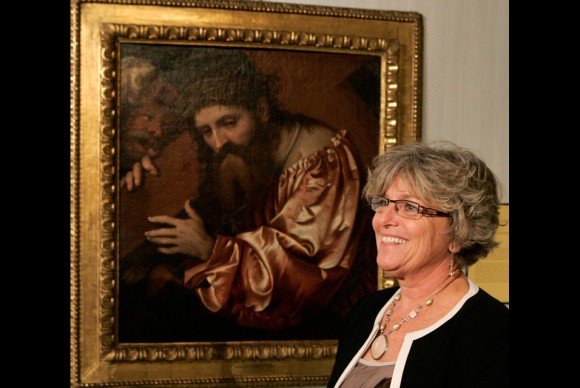United States authorities seize painting from Florida’s Mary Brogan Museum of Art & Science
November 6, 2011 by All Art News
Filed under Art Crime & Legal
TALLAHASSEE (AP).- U.S. authorities on Friday seized a nearly 500-year-old Italian painting that has been on display at a Florida museum, saying it was stolen by the Nazis from a Jewish family during World War II and should be returned to the family’s heirs.
U.S. Attorney Pamela Marsh announced Friday that the federal government will hold onto the painting until a federal judge can determine the rightful owners.
The Baroque painting was one of 50 lent to the Mary Brogan Museum of Art & Science in Tallahassee by a Milan museum for an exhibit that closed earlier this year. Federal authorities took custody of the painting after three museum employees wearing white gloves took it down from the wall and placed it in a custom-made padded crate.
The painting, “Christ Carrying the Cross Dragged by a Rogue” by Girolamo Romano, came from the Pinacoteca di Brera museum in Milan. The painting is believed to date to around 1538 and it was purchased by Federico Gentili di Giuseppe in 1914 during an auction in Paris. He died in 1940 shortly before the Nazis occupied France.
The painting is believed to been among 155 works auctioned off by the French Vichy government in 1941 in order to pay off debts. But members of di Giuseppe’s Jewish family who fled the country because of the Nazi occupation have said the sale was illegal.
Court documents filed by U.S. authorities on Friday contend that the Milan museum — which is owned by the Italian government — should have known that the painting was claimed by the di Giuseppe family. Lawyers for the family wrote to the museum back in 2001 about the painting, which had been acquired by the Pinacoteca di Brera in 1998. The Italian government had been contacted previously about the painting as well.
“Our pleadings make it very plain that we believe the heirs of Federico Gentili are the rightful owners,” Marsh said.
Chuca Barber, the chief executive officer for the Brogan, insisted her organization did not know about the dispute over the painting when it made the deal to bring over the exhibit from Milan.
“The Brogan museum would not under normal circumstances research each individual painting,” Barber said Friday.
In September, Marsh’s office ordered the museum to hold onto the painting instead of returning it to Italy. Court documents show that the museum reached an agreement with Italian authorities to keep the painting until this Sunday.
On Friday, Marsh’s office got permission from a judge to let U.S. customs agents to seize the painting. U.S. officials would not say who initially tipped them off about the painting this past summer.
Michael Kennedy, assistant special agent in charge of Homeland Security investigations, said the painting, which had been insured for more than $2 million, was being taken to an “undisclosed location.”
“It’s an expensive painting, we’re not going to tell anyone where it is,” Kennedy said.
Jennifer Kreder, a law professor at Northern Kentucky University and chair of the American Society of International Law’s Cultural Heritage & the Arts Interest Group, said there have only been a handful of instances in which state or federal officials in the U.S. have seized art believed to have been stolen by the Nazis.
Back in 2000, two American museums reached settlements with the heirs of di Giuseppe that allowed those museums to keep two pieces of artwork that were in their collections. A French court in 1999 returned five paintings to the family from the Louvre museum in Paris.
In 2008, the American Association of Museums released guidelines for museums to follow to avoid acquiring artifacts that may have been illegally exported. Museums including the Metropolitan Museum of Art in New York and the J. Paul Getty Museum in Los Angeles have agreed in recent years to return artifacts to Italy that the Italian government says were looted or stolen.
Since 2007, the Homeland Security Investigations directorate in the U.S. Department of Immigration and Customs Enforcement has returned more than 2,500 items to more than 22 countries including paintings from France, Germany and Austria as well as cultural artifacts from Iraq.
“It’s never too late to right a wrong,” ICE Director John Morton said in a statement about the seizure. “Many people know about the massive theft and illegal sale of precious art belonging to Jewish families during World War II. They should also know that today there is an international network of law enforcement agencies working diligently to correct these injustices.”

